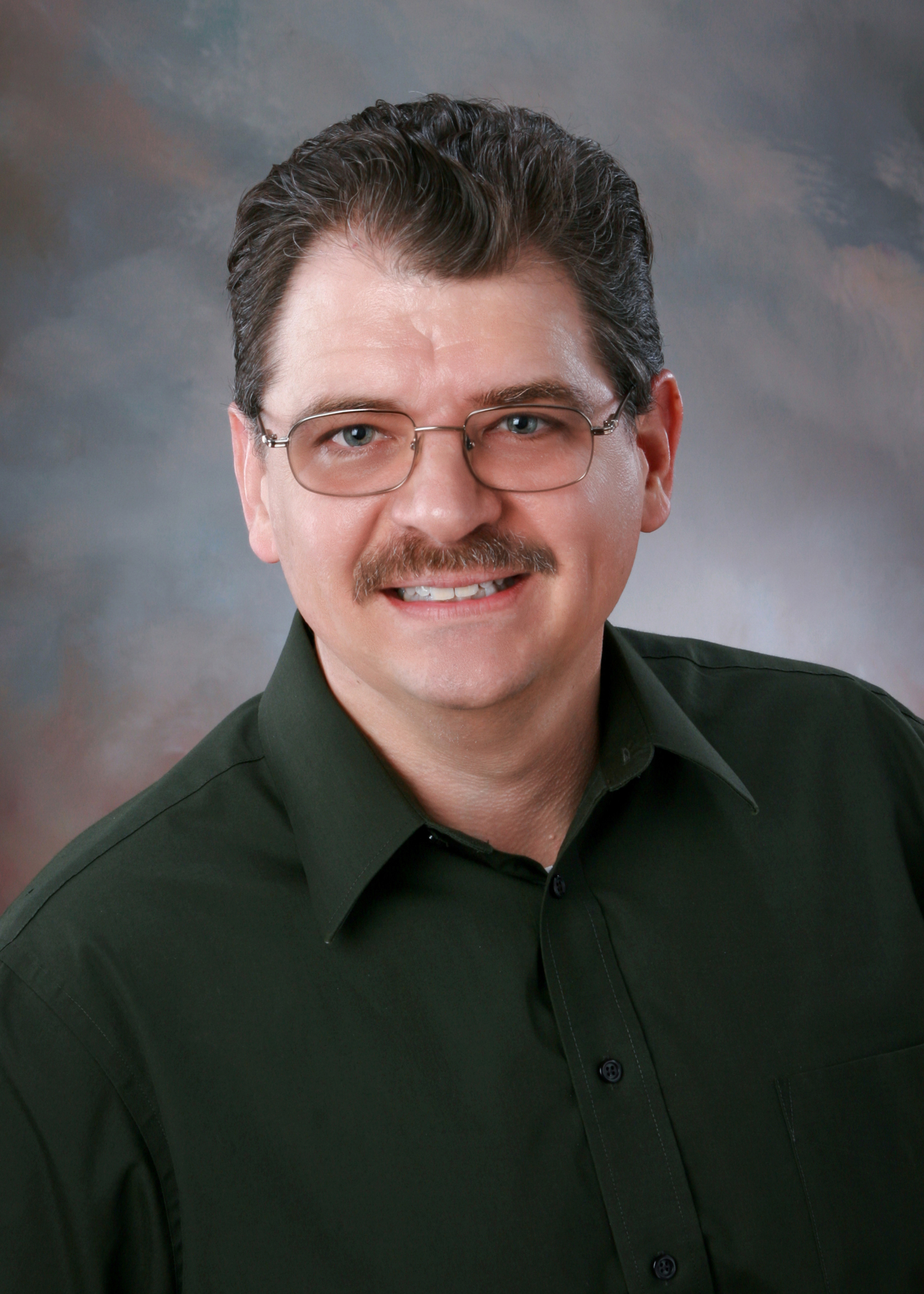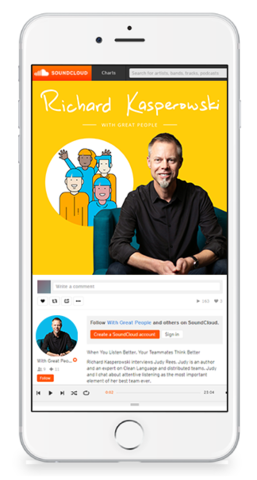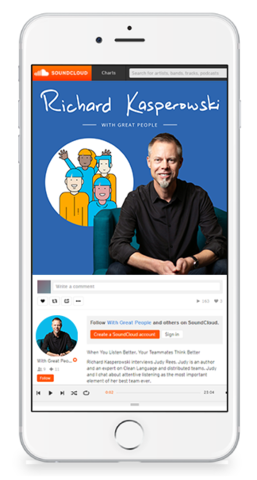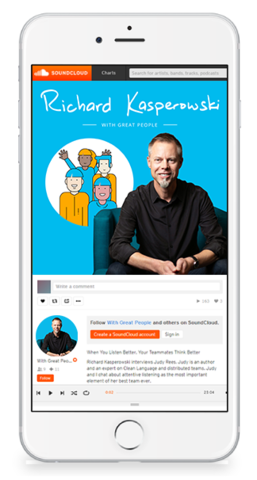Categories
Mark Kilby: How to Stay Together in a Distributed Team?
In this episode, Richard interviews Mark Kilby, a coach, and mentor to distributed teams. Mark co-authored the book From Chaos to Successful Distributed Agile Teams with Johanna Rothman, and he designed many online courses on the subject. We talk about finding a shared vision even when being miles apart, and how to build a better virtual workspace. When you finish listening to the episode, connect with Mark on Twitter and LinkedIn, and visit his web-site at https://www.markkilby.com.
Mark Kilby: How to Stay Together in a Distributed Team?
with Mark Kilby
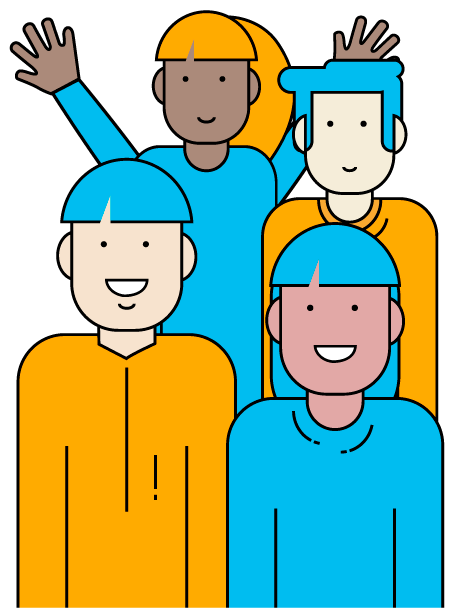
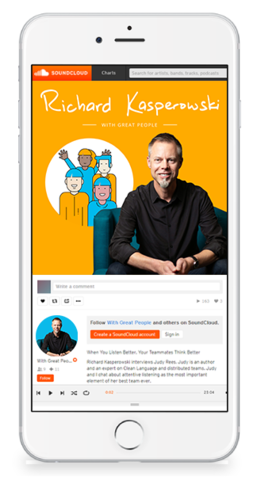
TRANSCRIPT
Richard Kasperowski (00:11):
Hi friends, welcome back to With Great People, the podcast for high- performance teams. I’m Richard Kasperowski. Remember back when distributed teams were an esoteric experiment and human collaboration. Well, fast forward a few centuries, maybe it’s only been five months if you still mark time with the Julian calendar, distributed teams have become the only way to work together. Many teams had to jump on this wagon with little or no preparation. In this episode, I talk with Mark Kilby and agile Floridian who is a coach and mentor to distributed teams. Mark co-authored the book, From Chaos to Successful Distributed Agile Teams with Johanna Rothman. And he’s designed many online courses on the subject. He shares a few techniques that can help teams find shared vision even when team members are hundreds or thousands of miles away from each other. To support this podcast, visit my website kasperowski.com. With us today we have Mark Kilby. Hi Mark, how are you?
Mark Kilby (01:15):
Hello Richard, great to be here.
Richard Kasperowski (01:17):
Great to see you and I love we both put on our podcast voice for that.
Mark Kilby (01:21):
Yes we did. I like to call it my theater voice.
Richard Kasperowski (01:27):
Well Mark, would you introduce yourself to our listeners please.
Mark Kilby (01:31):
Sure. And I’ll try to do it in a normal voice. So, longtime agile coach, even longer time working with all kinds of teams including distributed teams before I work with agile teams. And so, I’ve always wrestled with that question of what does it mean to be face to face and collaborate well? So that’s been my work over, I’m afraid to say, the last 20 years and I have the gray hairs to prove it, but yeah. So, working now in an organization that is fully distributed, so we all work out of our homes and it’s a sizable engineering organization, about 130 people. I’ve lost count of the number of teams because we have three coaches now, I’m one of those three coaches. But it’s amazing how well it works and that’s been the fun part of the last six years of that journey.
Richard Kasperowski (02:27):
Wow. I want to hear more about these distributed teams and [crosstalk 00:02:31].
Mark Kilby (02:31):
Yeah, I thought we might chat about. Yeah.
Richard Kasperowski (02:33):
Let’s just go there right now. What else could you share about distributed teams? Before we started recording, I shared a story about a distributed team I was working with and we were talking about using Zoom video conferencing and virtual backgrounds and how much fun that can be.
Mark Kilby (02:48):
Yeah.
Richard Kasperowski (02:49):
What’s something interesting about these distributed teams that you’ve been working with as long as six years now?
Mark Kilby (02:53):
Yeah. Well actually, I’ve been working with distributed agile teams since about 2003. When I was first using Scrum at the time I was very successful with some co-located teams and then my management said, “You know what? You’re so successful, we want to give you this team in Philadelphia but you have to stay in Orlando.”
Richard Kasperowski (03:11):
Right.
Mark Kilby (03:12):
I’m like, “Oh, great.” And at that point I had to start figuring things out, how do I make this work? How do I get a sense of how are the teams working? Are they connected with each other? Do they understand each other? And I’ve been working on that problem, like I said, for the last 20 years. How do we make that work? So, one of the things in the recent work of the last six years of that fully dispersed team, what I like to call a Nebula team, because they’re all out in space man that’s why, so. But one of the cool things is everybody has equal access that way, so there’s not people in an office and those remote. Because then you have that disparity of communication channels which is always a problem, with our teams we don’t have that.
Mark Kilby (03:54):
But another thing that I think is important is giving people choice, so that starts right from the interviewing and recruiting stage. And so, we let people know, here’s the environment you’re coming into and even if they’ve only worked remotely like once a month, once a week, we let them know this is very different. This is you not actually seeing your colleagues for months at a time unless you get comfortable with getting on video. And so, we actually spent a lot of time in the interviews talking to them and not really selling them, but just seeing how do they react to that? How have they experienced remote? So, choice is very important as part of that, building a great team whether it’s co-located or not but especially remote.
Richard Kasperowski (04:45):
All right. Yeah. I love that, the idea of choice. And this idea of parity you said it as making sure there’s no disparity between people in different contexts. Like a bunch of people in a room together at the central office and one person remote it’s a big challenge.
Mark Kilby (05:03):
Yeah. That’s what I refer to as the satellite team because they’re sometimes far out in orbit and you want to bring them closer in. And in some cases there’s non-tech solutions to that. So, I think you’ve heard me talk about the buddy system approach to that one.
Richard Kasperowski (05:23):[inaudible 00:05:23] that again, what is that?
Mark Kilby (05:24):
Yeah. So, let’s say you have a meeting in one of those satellite teams you’ve got everybody huddled in a meeting room and you’ve got those one or two remote people. So, what I tend to do is I’ll ask the group in the room with me, “Hey, I’m busy running the meeting for all of you, could it be possible that since we’ve got two people remote, could two people here connect with them, watch out for them? Connect with them on chat and just see, can they hear everything? Can they get their questions out there? If we’re doing an activity, I want you to be their proxy.”
Mark Kilby (05:58):
And so, that keeps those people very much aware of those that are not in the room, so there is still a connection. And I find that in many cases when I’ve done this, people will say, “Oh yeah, I know Joe, I know Mary, I’ll connect with them.” And even if they don’t have a shared chat tool we’ve got these funny little devices called smart [crosstalk 00:06:18] and most of the time the other team members have a way to connect with them that way. So, just giving them the choice to connect and making sure there is connections, it’s still not parody but it’s getting closer. And even when you have those mixed or hybrid teams.
Richard Kasperowski (06:37):
Yeah. I love this idea of the buddy system and it’s super effective. I also love the metaphors you’re using, first you said the Nebula organization and satellites.
Mark Kilby (06:48):
Yeah. And then another pattern that I see often is what I call the cluster. So, it’s a cluster of people in one location, a cluster people in another location and you have an entire team spread across these clusters. And you can imagine where the communication defaults to just those locations and very little in between. So, how do you equalize that? Buddy system’s part of that, another non-tech approach is having a copilot. So, the copilot is your co-facilitator or anybody who can read the room. So if you’re in a meeting, it’s watching the body language, watching the facial expressions in your particular location.
Mark Kilby (07:31):
They don’t even have to be an experienced facilitator, but they do need to be able to know they’re that part of the team and say, and they might type a message in a side channel, a chat channel, say, “It looks like we’re losing the crowd here, maybe you want to go back over some of those things you just covered on the backlog or whatever.” So, having that idea of pairing. And if you have multiple locations you’re almost mobbing on the facilitation, so you got multiple people helping hold the container for facilitation.
Richard Kasperowski (08:04):
I love this idea, a copilot for each cluster. Yeah.
Mark Kilby (08:07):
Yeah. So, I like to use the metaphors because when I really started digging into this stuff, trying to remember what distributed versus dispersed versus virtual versus remote, it’s like nobody uses those terms consistently. I’ve got to come up with a way for me to make sense of it, so that’s why I use the metaphors.
Richard Kasperowski (08:29):
I love it. And I was trying to echo you, you said distributed but then I said virtual and I knew that wasn’t right.
Mark Kilby (08:34):
Yeah.
Richard Kasperowski (08:35):
And it doesn’t even sound right, virtual sounds like it’s not real but it is a real team.
Mark Kilby (08:41):
No, they’re real teams. Yeah. I have lots of real teams that just happen to be spread out in different locations. But they communicate very well, they collaborate, they pair, they mob, they swarm on the work, so.
Richard Kasperowski (08:55):
All right. Let’s transition to my next big question. We’ve been talking about teams, the teams you’ve been working with for the last 20 years and more recently at this company where you are. What I’d like to ask people about is the best team of their entire life that you’ve been a member of, right? This could be you’re work team, this could be a notwork team, any group of two or more people aligned with a common goal. What’s the best team that you’ve been a member of in your entire life Mark?
Mark Kilby (09:26):
You know you warned me about this question and it’s still tough to pick that one. So many great teams that I’ve worked with in all unique and different ways, but I’m not going to take your example of the family, I’ll put it that way. Because I didn’t want to use that one, so I’m going to pick another example. A group of us in Florida that have each grew our own local user groups, so Agile Orlando and Tampa Bay and South Florida, there’s some others now popping up. And we started reaching out to each other just to share ideas. And then we said, “Hey, would it great to have a conference together?” But we wanted something a little different.
Mark Kilby (10:07):
And so, we went with more of an open space approach where the people gathered can really choose and drive the conversations. What is amazing about that team, that organizing team we’re planning our seventh year now, is sometimes we don’t even have to meet. We’re so focused on how do we bring people together across the state? How do we bring this community together? How do they share what they’ve learned? How do they share their struggles? And how do we set up opportunities for them to take that outside of the event and start new things? So new groups have started, new initiatives have started out of this. But the thing I like is my myself and my two co-founders, Stephanie Davis and Ryan Dorrell, as we started this we are just so focused on that goal of bringing the community together, to have the community share.
Mark Kilby (11:03):
That there’s been some years we’ve hardly met because we can coordinate everything through Slack, so we have our own Slack channels, and we can quickly bring the conference together. We had a venue fall through, two and a half months to go I think, and we quickly scrambled, we coordinated and we pulled together a new venue and we’ve actually been… We like that venue so much we’ve been there three years now. But it’s just amazing how quickly we react and pull together as we look at, okay, what’s something new we can do to bring the community together. And it’s been just one of the most awesome teams really, and we rarely see each other.
Mark Kilby (11:44):
Because they’re in Tampa, I’m in Orlando, we have a volunteer team that’s literally spread across the state of about 30 people and we rotate some in and out each year. We have a great process to integrate them into the decision making and it’s a new team every time, but it still has a lot of the same characteristics. And the thing that gets people excited about volunteering is it’s usually the first time they’ve attended the conference and they go, “I never knew a conference could be like this. How can I help?”
Richard Kasperowski (12:17):
Nice.
Mark Kilby (12:18):
And that’s the entrance, that’s the entrance fee essentially preferred to becoming a volunteer. It’s like, “You got it, you now understand exactly what we’re trying to go for.”
Richard Kasperowski (12:27):
All right. This sounds like a really great team. And a lot of the things you described about it are unusual and interesting. Like it is a distributed team, there’s three core members and there’s a lot of dynamic members of the team.
Mark Kilby (12:41):
Yeah.
Richard Kasperowski (12:42):
It’s also cyclical, right? Because it’s organized around putting on this annual conference. It’s a little bit of a team in the past, it’s a little bit of a team in the present. When you’re with this team or if you took yourself back to one instance of the team, what does it feel like? What does it feel like within you? What’s the sensation of being part of that team? And could you summarize that sensation in one word? What would that one word be?
Mark Kilby (13:08):
This might sound, actually I’m not sure how it will sound, but I would say gestalt. It’s greater than the whole.
Richard Kasperowski (13:15):
Gestalt. Oh, cool.
Mark Kilby (13:16):
So it’s not just the conference that we talk about, but we’ll talk about other events coming into the state, we’ll talk about how we can coordinate on that. We’ve dealt with some challenges, so we’ve had trolls in our cyber community come in and we’ve had to deal with that. But the way we quickly coordinate we realize it’s nobody doing this alone. It’s nobody having to build it or make it happen alone, it’s you’ve got people you can reach out to at any time to bring the community together and resolve whatever it is or move forward whatever it is that the community is focusing on.
Richard Kasperowski (13:57):
So, gestalt?
Mark Kilby (13:58):
Yeah.
Richard Kasperowski (13:59):
Redefine gestalt a little more. This is one of those words that I have trouble understanding. I try to look it up in the dictionary sometimes it’s not in the dictionary because it’s sort of an English word, sort of not. What does gestalt mean for you?
Mark Kilby (14:11):
It’s really you’re part of something bigger. It’s something you can’t possibly imagine achieving on your own. And the funny thing is one of my former companies was called Gestalt.
Richard Kasperowski (14:24):
Okay.
Mark Kilby (14:24):
And that was some other teams I was thinking of because there was a lot of great teams, including the executive team, which I had an opportunity to work with. And they always face the challenges together. They knew they were stronger together, it wasn’t anybody going off and battling the dragon on their own, so to speak, whatever popped up. So, it’s that understanding that whatever opportunity or challenge comes up this team can handle it. They’ll take it on, they’ll do well, tales will be told.
Richard Kasperowski (15:01):
We can use the onstage voice again, tales will be told.
Mark Kilby (15:05):
Told. Yeah. So for instance, those folks from Gestalt, I haven’t worked with them in over 10 years, but I’m still in touch with many of them. So, it’s just connections that have lasted because we also respect each other. We respect abilities, we respect how we worked as team members, and some will still reach out to me and say, “Hey, would you mind reviewing this with me real quick?” So, in a way we’re still a team even though we’re not working together.
Richard Kasperowski (15:38):
Yeah. I ask enough people these sorts of questions that I start to hear things that are patterns and themes. And these are some of the themes, we’re still in touch with many of them and there was a lot of respect. So, these are beautiful things.
Mark Kilby (15:52):
Yeah. And you and I having worked with so many different organizations and teams, it’s disheartening when you realize somebody doesn’t have that experience. It’s like, “All right, how could we make that experience happen for you? Because it’s awesome.” Because you know this team can do anything.
Richard Kasperowski (16:12):
Yeah. But let’s dig deeper into the experience a little bit and then we’ll get into how we could help other people get there themselves. Actually you pick, it could be the Gestalt team, the company, or it could be this team, the conference organizers that are in this state of gestalt together. How do you know? Pick one of them. How do you know that it was a great team? Either subjectively just the feelings you had while you’re doing the work together? Or objectively, what are some things that an outside observer would notice?
Mark Kilby (16:44):
I think immediately it’s a shared vision of how we want to work together. Really how we want to be together. So, I recall some of my early conversations with Stephanie and Ryan when we first started talking about organizing Agile Florida. We weren’t looking at setting up a nonprofit organization, we weren’t worried about any of the administrivia it was more about, we’re doing some interesting things, we know that each of our local communities can benefit from sharing. How do we bring everyone together? So, we had that common vision and the way an outsider can see it and I’ve seen many cases of this with that particular team, that Agile Florida team. If somebody walked up to any of the three of us and asked a question about what’s next? Or how does this work? You would probably get a similar answer because we have that shared framework, that shared vision of how do we always bringing the community together to learn, to teach, to accomplish challenges?
Richard Kasperowski (17:53):
I like that, that’s very objective. Ask anybody on the team and you get the same answer.
Mark Kilby (17:58):
Yeah. Or similar, so it doesn’t have to be the same. We don’t want robots, so.
Richard Kasperowski (18:04):
Yeah. And you probably trust each other, whatever the answer was that’s the right answer.
Mark Kilby (18:09):
Yeah.
Richard Kasperowski (18:10):
What are three concrete behaviors that you have used or you currently use on this team that go into its being such a team?
Mark Kilby (18:18):
Yeah. So, I would say if you’ve got that shared vision, trusting that people are always working to their strengths to fulfill that vision, also trusting that people will reach out for help when they’re struggling and that others are there to provide that help. So, I emphasize that with every team that I work with. A team is not micro silos, you’re a team, you’re focused together on doing great things together, so how can you do that better? How can you leverage each other’s strengths? How can you be aware of each other’s weaknesses so you know how to jump in even sometimes before somebody asks?
Richard Kasperowski (19:09):
What’s one of those tools that you use to get people to be mutually aware of each other’s strengths?
Mark Kilby (19:15):
So, I wish I knew about your Team Transformation Canvas earlier, so that’s going into tool kit.
Richard Kasperowski (19:22):
Oh, cool.
Mark Kilby (19:23):
Because that is very much aligned with some of the things that I tend to coach.
Richard Kasperowski (19:29):
Uh-huh (affirmative).
Mark Kilby (19:29):
But I’ve tried many things over the years, so I’ve tried Myers-Briggs, I’ve tried DiSC, I’m still a big fan of StrengthsFinder but the challenge is most people don’t know what to do with that information that you get out of those kind of assessments. And they don’t know how to make the team work based on that, unless you’ve got some expert. There’s others, especially for distributed teams, that are online that can help form that shared vision and help establish working agreements. But sometimes I find that simple exercises very early in the team’s formation can help with that. So one that I like, and we even put it in the book it’s called, the compass activity.
Mark Kilby (20:12):
And it’s very simple, you could do this in a room with everybody, or you could do this online in a shared document, but making sure that if you do it online, that everybody can move things around in that document. So, typically what we start with is a compass diagram with explanations of, “Okay. So, this diagram is an example of where people might tend to move into action first. So North is, I like to just jump into action, I want the team to move. I don’t want us to sit and debate anything. South is, I really want to get everybody’s input before we move forward on this. East is, I think we need the big picture before the team moves forward and West is, we need all the details before we move forward.”
Richard Kasperowski (21:00):
Mm-hmm (affirmative).
Mark Kilby (21:01):
And then what I do is, if I’m doing it online is, I’ll grab the avatars out of chat or email or whatever tool they’re using, it’s how do people tend to recognize them online? So, whatever image they use for that and I don’t care what it is just as long as their team knows who it is. And I’ll say, “Okay, move your avatar to the compass point that typically represents how you act.” And then they step back and they look at where do people put themselves and where are they in relationship to each other? And that’s where you hear the ahas! They go, “Oh, now I see why Tom gets so upset with us when we’re debating on how to do this because he’s in the North.” Or things like that. And there’s actually a series of debrief questions with the exercise.
Richard Kasperowski (21:45):
Nice.
Mark Kilby (21:46):
Just to look at how do you let people know about where you are on the compass? And how you prefer to work? How do you work with others? When do you not work well with others on other parts of the compass? And what can you do to mitigate that? And so that helps them start exploring, okay, we really need some working agreements around this. Now we see why we have to do this. You can run that in 30 minutes, you can run that in 90 minutes. I’ve run repeat sessions with teams that say, “Hey, it seems like the dynamics have changed or something we haven’t discovered, could we run that one again?” There’s some other ones like that but that’s a favorite one that a lot of my teams seem to enjoy.
Richard Kasperowski (22:26):
I love that. And I would be that person at the North end of the compass getting frustrated with.
Mark Kilby (22:32):
Yeah, And I’m typically at the South so I’ll tell them, “You’re probably going to get really impatient with me because I’m going to wait until I get everybody’s input on this exercise.” And so, they laugh like that when I tell them that.
Richard Kasperowski (22:43):
Yeah. I look back at myself and my behaviors with some of the teams I’ve been part of and becoming frustrated that we can’t just go and do it.
Mark Kilby (22:49):
Just do it. Yeah, so.
Richard Kasperowski (22:52):
And you said this is in the book. Tell us about the book.
Mark Kilby (22:55):
Oh, yeah. So, I had this wonderful opportunity to pair right as a distributed team with Johanna Rothman, we released the print version in April of 2019. The ebook version has actually been out sooner than that on Leanpub but now we have it on Amazon and many others, and there’s more to come around that. But the book is-
Richard Kasperowski (23:22):
Title of the book?
Mark Kilby (23:23):
Yep. The book is entitled, From Chaos to Successful Distributed Agile Teams. Because most people who experience distributed teams feel like this is insane, this will not work and that’s not our experience. So, both Johanna and I have worked with many distributed teams and so we looked at where have we seen success? And that’s essentially what the book covers. We talk about some of the distributed team types, satellite, Nebula, cluster, some other types of teams that people might encounter. We talk about what’s really the problem, it’s not time zones, there’s another way to look at that. We talk about communications, setting up your virtual workspace, setting up your personal workspace as well. We finally talk about process in chapter nine, which probably most people go, “why do you wait so late?” Because you have to think about all those other things first. And then we talk about hiring and what we refer to as integration, some would say onboarding. And we also talk about the important role of leadership in establishing these environments.
Richard Kasperowski (24:29):
Nice. This’s definitely a book I’m going to check out. I want to say I’m going to crack it open, but I’m going to read it electronically. I don’t know what you say electronically it’s like, “I’m going to crack [inaudible 00:24:37].”
Mark Kilby (24:38):
I don’t know, it’s slice it open. I don’t know.
Richard Kasperowski (24:39):
Yeah. How about some advice for listeners. The success of this Agile Florida conference organizing team? What could listeners do to reproduce some of this team’s success?
Mark Kilby (24:52):
So, I can’t emphasize enough the importance of a shared vision. So, you’ve always got a core set of members that have that they’re the vision keepers, but if they’re not sharing that vision out to the broader team or whoever the team is interacting with, that gets lost. So, you’ve got to spend time, you’ve got to keep repeating that vision until you start hearing it getting echoed back and say, “Okay, people have it now.” Because that allows you to let go of many different things. You don’t have to micromanage, you don’t have to track every detail, you don’t have to plan out every task you just say, “Hey, we need this done. Can some of you pair up?”
Mark Kilby (25:31):
So that’s another thing is not just have one person go and tackle something, but can you pair up so you get different perspectives on the work. And also, especially if it’s a team like a volunteer team which those are, if somebody has to drop out for some reason, there’s still somebody there that can carry on that particular task. But that works very well in our other teams, having that ability. So having a vision, having a way to pair and collaborate together, I find it works very well. And also the last thing is emphasizing that idea of choice, so do the teams have a choice of how they work? Do they have a choice of when they work? So, giving them that choice gives them a lot of power and creativity on getting to the goal.
Richard Kasperowski (26:19):
All right. Is there anything else you’d like to add?
Mark Kilby (26:22):
Sure. So, Johanna and I have continued to be busy on the work of the book, we are working on online courses, so if people want to dive deeper with Johanna and I online, can certainly check my website or hers. And-
Richard Kasperowski (26:40):
And what’s your website?
Mark Kilby (26:41):
Ah, thank you. So, my website Is markkilby.com. Two Ks in the middle there.
Richard Kasperowski (26:49):
All right. Is there anything else listeners can do if they want a way to get in touch with you?
Mark Kilby (26:52):
I’m also on social media, Twitter and LinkedIn are best. On Twitter it’s MKilby, M-K-I-L-B-Y, and LinkedIn just search for me, I’m pretty easy to find on LinkedIn. And I’m active on both these platforms.
Richard Kasperowski (27:07):
All right. Well Mark Kilby, thank you so much for joining us today. This has been super fun.
Mark Kilby (27:12):
I’m so glad we’ve finally got a chance to do this too.
Richard Kasperowski (27:15):
Me too. Thanks so much.
Mark Kilby (27:22):
Thanks.
Richard Kasperowski (27:22):
Hi friends, thanks for listening. And remember to support this podcast, sign up for my newsletter at kasperowski.com.
